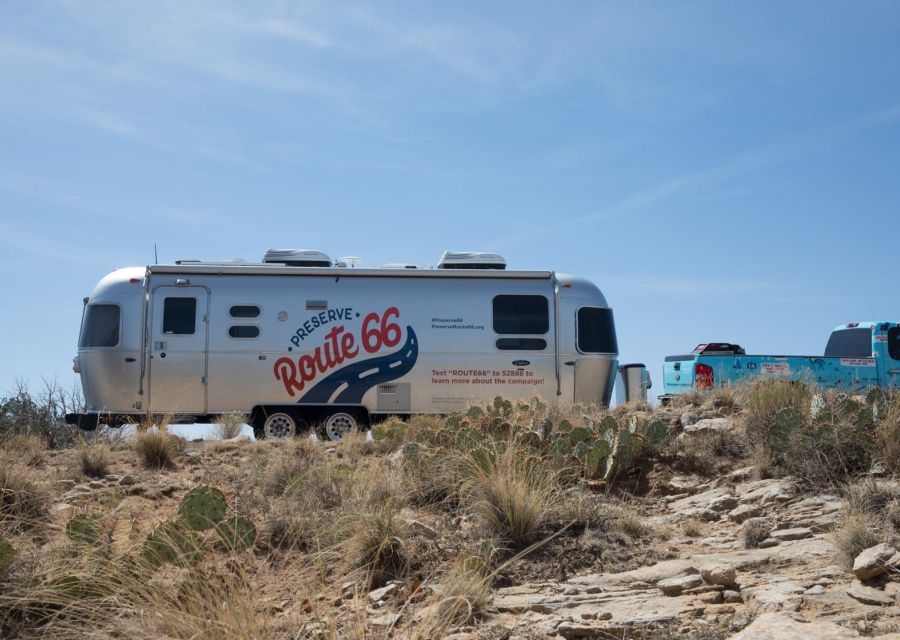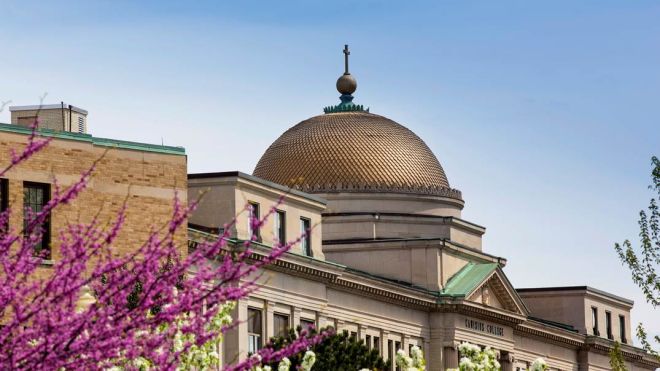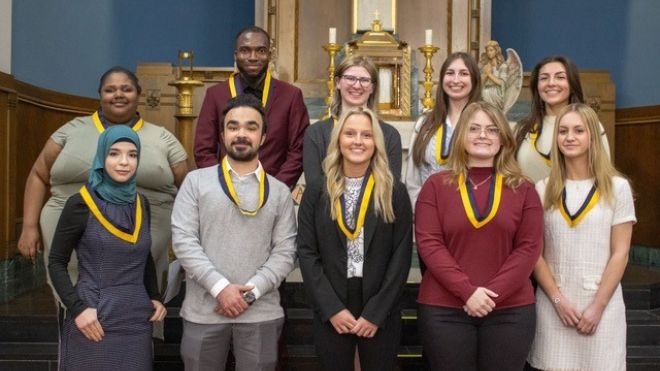
BUFFALO, NY - Ever since cars could go the distance, road trips have been an integral part of Americana. Windows down. Music up. Nothing but the open highway ahead.
Of course, no two words tempt the freedom and unparalleled adventure of a road trip quite like ‘Route 66.’ It’s here, along this 2,488-mile cultural roadway that Canisius Magazine caught up with photographer David A. Kafer ’08.
Traveling in a 27-foot Airstream trailer, Kafer was on the quintessential American road trip in which he spent five weeks journeying from the start of the historic highway in downtown Chicago, through eight states and three time zones to its eventual impasse at Southern California’s Santa Monica Pier.
“The nostalgia of Route 66 is just as you would imagine: retro diners, restored filling stations and neon-lit signs. But it’s so much more,” Kafer says. “It’s the chance encounters along the way, the people you meet who live and make their living along the highway, and who shape the character and contributions of Route 66 in our nation’s history.”
Upholding that history became a full-time job for Kafer when the National Trust for Historic Preservation engaged him for its cross country advocacy campaign to have Route 66 designated a National Historic Trail. Kafer’s assignment: to capture the spirit and stories along this Main Street of America, and help spur critical preservation efforts for the communities and small towns that call it home.
It was an opportunity of a lifetime for Kafer who didn’t discover photography until his senior year at Canisius.
“I registered for a travel photography class to Italy thinking it would be a fun and easy three credits before I graduated,” Kafer recalls. “Instead, the trip changed the direction of my life and the way I viewed the world.”
Kafer credits Thomas A. Wolf ’86, assistant professor of fine arts at Canisius, for “teaching him how to see,” and “inspiring me in a way that no professor has, before or after my time at Canisius.” It was also at Wolf’s encouragement that Kafer pursued his master of fine arts from the Brooks Institute of Photography in Ventura, CA.
Today, Kafer is a successful commercial photographer based in Los Angeles with a clientele focused on fitness, lifestyle and sports brands. He is also the force behind The Portrait Project: 100K, a social justice initiative that invites people to be photographed while sharing personal experiences that changed the ways in which they perceive the world. Kafer aims to photograph a total of 100,000 people from across the U.S. over the next few years. Their pictures and stories are published on The Portrait Project website.
“There are many differences between each of us but there are also many similarities,” he says. “The mission of The Portrait Project is to break down those barriers that divide us and bring people together by illustrating how we are all more alike than not.”
The Portrait Project satisfies Kafer’s principle rule of photography, which is to “shoot what’s important to you.” And it’s for this reason that he readily joined the National Trust for Historic Preservation campaign to name Route 66 America’s 20th National Historic Trail, putting it in the same company as the Lewis and Clark Trail and the Pony Express.
“It literally takes an act of Congress for this to happen but if it is successful – and a bipartisan bill already passed in the House and is headed to the Senate – hundreds of communities and small towns that line the highway would be eligible for federal funds to help preserve, develop and promote Route 66.”
Kafer was the sole photographer among a handful of millennial roadies who traversed the both enduring and endearing route, and documented their trip through words and images. The photographs that follow feature just a few of Kafer's compelling images, which essentially capture two tales of Route 66: One of a largely diminished roadway that once symbolized transportation and tourism in the United States. Another that, at least in spirit, remains an indelible slice of Americana.
THE ROOTS OF ROUTE 66
Officially commissioned in 1926, Route 66 linked predominantly rural communities, which enabled farmers to transport grain and produce for redistribution. The historic highway later came to represent the road to opportunity following the Great Depression, when an estimated 200,000 Great Plains refugees escaped west, from the despair of the Dust Bowl. During World War II, the Mother Road facilitated the single largest mobilization of military manpower and equipment to California and the Asian front.
This newly-restored 1.4 mile stretch of Route 66 between Chatham and Auburn, IL, shows the road's original hand-laid brick.
Those who stayed behind following the Dust Bowl found their fortune in mining. Here, David Kafer captures the faded glory of Galena, KS, once a major producer of lead ores during World War II. Its location on Route 66 positioned Galena along an important corridor for the mining network and the town grew to become one of the most prosperous along the historic highway. By the 1970s, however, a new Interstate bypassed Galena and the town fell on hard times, losing 90 percent of its population.
There are a few signs and little fanfare directing visitors to this World War II internment camp, which stands along America's most fabled road in El Reno, OK. As many as 1,300 "German prisoners of war were housed here," Kafer explains. Captured fighting in North Africa, the POWs were brought to the Sooner State and "put to work picking cotton and clearing fields."
Born and raised along Route 66 in Seligman, AZ, Angel Delgadillo witnessed the mass exodus of people escaping the Dust Bowl in the 1930s. He saw the movement of troops and materials West during World War II. He and his family also prospered during the heyday of Route 66. So when traffic along The Mother Road was all but diverted to the newly-opened Interstate 40, the barbershop owner took action. He formed the Historic Route 66 Association, the first ever Mother Road preservation association, which is helping to return traffic and tourism to Route 66.
ROUTE 66 HITS ITS HEYDAY
It wasn’t until the post-war era that Route 66 had its heyday. An unprecedented economic boom gave more Americans the means to buy cars and the leisure time to travel with them. Communities, interlaced along The Mother Road, catered to these consumer impulses and soon the artery’s landscape bore a slew of locally owned motels, mom-and-pop shops and retro roadside restaurants.
The Desert Hills Motel in Tulsa, OK, is a classic along Route 66. Built in 1953 to house an increasing number of travelers following a long day's drive, the motel offers 50 units, each lined up diagonally. "It's an unusual but efficient architectural design," says Kafer. The motel remains perfectly preserved and continues to attract guests with its glowing neon green cactus sign.
Faithfully restored in 2009, the Palms Grill Cafe in Atlanta, IL has been catering to hungry locals and Route 66 travelers since it first opened in 1934. The eatery served up a slice of nostalgia along with its "made-from-scratch coconut cream and pecan pies" and "the atmosphere makes even a stranger feel like a regular," recounts Kafer.
Wyman 'Bill' Deck* is a retired pharmacy technician who, along with his late brother, Bob, was the third generation to operate Deck's Drug Store in Girard, IL. The pharmacy opened in 1884 and a soda fountain was added in 1929 when the name changed to Doc's Soda Fountain. A popular tourist stop along Route 66, "visitors step back in time" when they visit Doc's, which continues to offer old fashioned sodas and invites guests to browse Bill Deck's pharmacy museum.
*Bill Deck passed away shortly after he was photographed for the Route 66 campaign.
VACATION WITHOUT DISCRIMINATION
“Not all travelers were treated equally” during the glory days of Route 66, Kafer learned, during his five-week journey. The expansive roadway became rife with racism during the Segregation Era, as white business owners banned African Americans from their restaurants, gas stations and motels. To help African Americans safely navigate a segregated Route 66, Victor H. Green, a black postal worker from Harlem, NY, published The Negro Motorist Green Book in 1936. Also known simply as Green Book, the pocket-sized travel guide “offered black travelers tips on black-owned places to eat, visit and sleep while making their way down Route 66,” explains Kafer.
American Indians shared a “similarly complicated history with Route 66,” he continues. The road weaved through the lands of more than 25 tribal nations, “physically intruding on communities and disrupting day-to-day life.” And although increased tourist traffic presented American Indians with new business opportunities, covetous entrepreneurs outside Native American lands tried to capitalize on the culture, often propagating false stereotypes to lure tourists for their own profit.
Edward Threatt stands inside the historic Threatt Filling Station on Route 66 in Luther, OK. Though not listed in The Green Book, it was one of the only safe places for African Americans traveling the road. The historic property sits on 160 acres and has remained in the Threatt family for more than 100 years.
Wigwam Village in Holbrook, AZ is an iconic - albeit controversial - piece of Route 66 history. Still in business today, it was one of the seven franchises built in the 1950s designed to offer guests a unique hotel experience. And though the idea of sleeping in a concrete tee-pee is attention-grabbing for tourists, to others, the loose representation of a Native American dwelling is a reminder of how cultural stereotyping remains socially acceptable.
GET YOUR KITSCH ON ROUTE 66
Who says a museum must be confined within four walls? David Kafer describes Route 66 as a venerable “outdoor exhibit of Americana.” Whether it’s a massive Muffler Man or the world’s largest catsup bottle, each roadside attraction is its own entertaining art form. “The quirkier the better,” says Kafer who notes that the eye-catching kitsch was “often a way for businesses to compete for tourists’ attention.”
Collinsville, IL is home to this whimsical water tower which stands at an impressive 167 feet. Nearly demolished in 1995, it was saved by none other than the Catsup Bottle Preservation Group.
Standing nearly 30 feet tall and weighing in at 438 pounds is the Gemini Giant of Wilmington, IL. "It's one of several Muffler Man statues along Route 66," Kafer notes. Muffler Men are giant, fiberglass advertising characters whose roadside popularity made them emblems along the historic highway. This green goliath holds a supersized rocket advertising the Launching Pad diner.
Travelers find it nearly impossible to drive through the ghost town of Oatman, AZ without stopping. That's because burros are often found blocking the road. These wild donkeys are descendants of those used by miners, nearly a century ago, to carry supplies. When the mines closed, the workers turned the mules loose. Today, they can often be found "wandering the town," Kafer says, "often seeking food from tourists."
Click here to view the full photo gallery.















